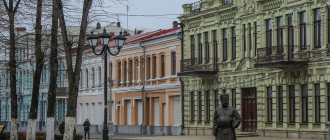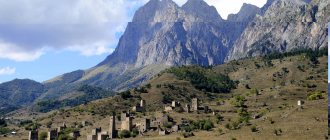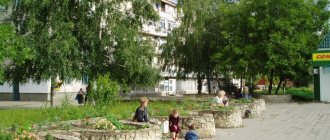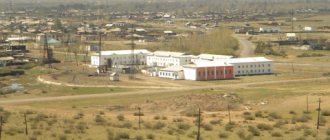For the defunct football team active from 1992–2000, see FC Alagir.
City in North Ossetia-Alania, Russia
| Alagir Alagir | |
| Town[1] | |
| Other transcription(s) | |
| • Ossetian | Alagir |
| Assumption Cathedral, Alagir | |
| Location of Alagir | |
| Alagir Location of Alagir Show map of Russia Alagir Alagir (North Ossetia – Alania) Show map of North Ossetia–Alania | |
| Coordinates: 43°02′N 44°14'E / 43.033°N Latitude 44.233°E / 43.033; 44.233Coordinates: 43°02′N 44°14'E / 43.033°N Latitude 44.233°E / 43.033; 44.233 | |
| A country | Russia |
| Federal subject | North Ossetia-Alania[1] |
| Administrative region | Alagirsky district[1] |
| City of district jurisdiction | Alagir[1] |
| Based | 1850[2] |
| City status from | 1938 |
| Height | 600 m (2000 ft) |
| population (2010 Census)[3] | |
| • General | 20,949 |
| • Evaluate (2018)[4] | 20,043 (-4.3%) |
| Administrative status | |
| • Capital from | Alagir district[1], Alagir city of district subordination[1] |
| Municipal status | |
| • Municipal district | Alagirsky municipal district[5] |
| • Urban village | Alagir urban settlement[5] |
| • Capital from | Alagirsky municipal district[5], Alagirskoye urban-type settlement[5] |
| Timezone | UTC + 3 (MSK [6]) |
| Postal code(s)[7] | 363240–363243, 363245, 363246 |
| Dial code(s) | +7 86731 |
| OKTMO I WOULD | 90605101001 |
Alagir
(Russian: Аlagir; Ossetian: Аlagir) is an industrial town and administrative center of Alagirsky District in the Republic of North Ossetia-Alania, Russia, located on the western bank of the Ardon River, 54 km (34 mi) west of the republic capital of Vladikavkaz. As of the 2010 Census, its population was 20,949.[3]
Story
The city was founded in 1850.[2] Prince Mikhail Semenovich Vorontsov, then Viceroy of the Caucasus, next to the ancient silver/my news nearby Alagir Gorge. It was built as a fortification around a smelter and became a major mining center. By the end of the 19th century it was increasingly populated by Georgians and Russians who came to work there. During the Russian Civil War in January 1919, Alagir became the scene of fierce fighting, which resulted in heavy casualties among the Georgian population and a difficult escape for survivors through the mountain passes into Georgia. Soviet leader Vladimir Lenin commented on the incident by blaming "counter-revolutionaries" for the atrocities in Alagir,[8] which Georgians tend to attribute to Ossetian radicals.[9]
Alagir received city status in 1938. [ citation needed
] During World War II, on November 5, 1942, the III Panzer Corps and the Romanian 2nd Mountain Division[10] (under von Kleist) captured the city and held it until it was retaken by Soviet forces in early January 1943.
Alagir is a city in the Republic of North Ossetia-Alania.
History of Alagir
Alagir is one of the old settlements of North Ossetia. He is about 140 years old. It was founded in the 50s of the XIX century. The beginning of the history of Alagir was associated with the decision of the tsarist government to build a metallurgical plant on the basis of the Sadonsky deposit of non-ferrous metals and to control the important Alagir-Kutaisi pass road connecting the North Caucasus with Transcaucasia.
The development of the Sadon deposit, as well as the smelting of lead and silver from its ores using artisanal methods, was started by the ancestors of the Ossetians - the Alans - back in the 5th century AD. The Alans were good miners and blacksmiths.
The first information about the Sadon ore wealth began to reach the government bodies of Tsarist Russia at the beginning of the second half of the 18th century. For a thorough study of the found ores, a geological expedition was sent to Sadon in 1768 under the leadership of the Siberian ore explorer Stepan Vonyavin, and in the same year the Sadonsky deposit of polymetallic ores was included on the geological map of the country. The expedition collected significant material about the reserves of lead, zinc, silver, and timber available in the Alagir Gorge and in general in the mountainous part of North Ossetia.
In addition, S. Vonyavin pointed out the possibility of building two silver-lead factories on the banks of the Ardona, Fiagdona or Gizeldona rivers, where there was a lot of construction and fuel material. To provide factories with labor, he proposed to resettle landless residents of the Alagirsky and Kurtatinsky gorges from the mountains to these places. Vonyavin’s plan was not implemented, but tsarism’s interest in the ore riches of Ossetia grew constantly, especially from the 19th century, since the long wars of the tsarist government led to the country’s great needs for lead, which were met by importing it from abroad.
In the 40s of the XIX century. The lack of lead forced the tsarist government to seriously take up the issue of surveying the Sadon silver-lead deposit in order to find out the possibility of “supplying” the troops with their own Russian lead.”
A comprehensive study of the deposit was carried out by the then famous geologist Carteron and mining engineer Reinik. They highly appreciated the possibilities of using the deposit and in 1843 the Sadonskoye deposit acquired national significance and its widespread industrial exploitation began. This year is considered the year of the beginning of the development of the Sadonsky mine as a state enterprise.
The first attempt at industrial development of non-ferrous metal ores of the Sadonskoye deposit was made by a private entrepreneur, a Turkish citizen, Greek Spiridon Chekalov. Until 1840, he was a contractor for stone work in the construction of bridges on the Georgian Military Road, where he managed to accumulate significant capital. In 1839-1846. S. Chekalov, with the permission of his superiors, organized the primitive development of the ores of the Sadonsky deposit and the artisanal smelting of silver and lead. With the help of a small
a primitive furnace, with hand fur in 1846, Chekalov smelted and handed over to the Treasury 11 pounds of silver and 3,400 pounds of lead, for which he received 18 thousand rubles from the treasury. He handed over lead to the “artillery of the Caucasian Corps”, and silver to the St. Petersburg Mint.
Primitive methods of mining ores and smelting non-ferrous metals - silver, lead and zinc - could not provide high labor productivity. Despite the fact that the richest ores were mined (with lead content up to 70%, zinc up to 60%), S. Chekalov’s enterprise suffered a loss and in 1850 became the property of the treasury.
According to the proposal of the Caucasian governor, on February 27, 1850, the tsarist government gave permission to establish a silver-zinc plant on the basis of the Sadonsky polymetallic ore deposit at the entrance to the Alagir Gorge, on the southwestern outskirts of the village of Salugardan.
The government allocated funds for its construction. In addition, it was planned to build along the river. Ardon is a dirt road 33 miles long. The implementation of these plans was entrusted to Lieutenant Colonel Ivanitsky of the corps of mining engineers. Under his leadership, in 1853, a metallurgical plant for smelting non-ferrous metals was built near the village of Salugardan, and a dirt road was laid from it to the Sadon mines.
The Alagir smelter was built by Donetsk, Ural and Altai so-called “state-owned mining artisans” and workers. The first batch of artisans and workers arrived from the Lugansk foundry in April 1850, the rest arrived later. 380 families were resettled from three regions of the country for the construction of the plant. The village that arose in 1850 near the plant was called “Alagir” (Uaellag Ir - Upper Ossetia), since 1863 - the village of Alagir.
Gradually, the village of Salugardan became part of it. By 1853, Alagir had 280 houses, comprising nine longitudinal and two transverse streets. Luganskaya Street was the first to be founded.
In the 90s of the XIX century. a large number of Ossetian mountaineers settled on the western outskirts of Alagir, where they formed a separate settlement called Krupe. Along with Russians and Ossetians, Georgians from the Kutaisi province also began to move to Alagir. They bought plots of land from the Russians and were mainly engaged in gardening, farming and various crafts, and also partially worked in mines and at a silver-lead factory. By the end of the 19th century. Alagir became a significant settlement. It was surrounded by a moat filled with water from the river. Ardona, it was protected by four bastions. Three gates were made to enter the village, which were decorated with pavilions with spiral staircases.
One of the first historical buildings of Alagir was a church-fortress, surrounded by a wall with loopholes and towers, built in the Byzantine style from cut trachyte stone according to the plan of the architect and artist Prince Gagarin, who was at that time in the Caucasus. It was built in 1850-1853. mason workers from S. Chekalov's detachment. This church-fortress ensemble has been completely preserved. It is located in the central part of Alagir. It is surrounded by centuries-old shady trees. This is the main historical attraction of Alagir. Nowadays it houses a local history museum, which widely displays exhibits characterizing the nature, economy and culture of Alagir and the region. The iconography of the church attracts attention. It was made by the hand of the great son of the Ossetian people, Kosta Khetagurov, who was not only a wonderful poet, but also a talented artist.
The Alagir silver-lead plant had the appearance of a fortress. It was surrounded by a moat filled with water, thick walls with loopholes, four massive cast-iron gates and four corner towers on which guns stood. Some of the buildings of the Alagir smelting plant have survived to this day (Ushchelskaya Street). On the territory of the plant there were workshops, a barracks, a forge, an office, a laboratory, a store and an apartment for the military commander of the fortification.
Near Alagir there was a pottery workshop that produced water pipes, as well as bricks and tiles using local raw materials. The Alagir silver-lead plant, according to experts, was supposed to smelt 100 pounds of silver and 35 thousand pounds of lead annually. In fact, the productivity of the plant, like the Sadonsky mine, turned out to be much lower. The plant did not justify the costs, but it was important: already during the Crimean War (1854-1855), the needs of the Russian army for lead were met precisely by the Alagir silver-lead plant, which annually supplied the military department with 585 tons of lead.
The Alagir plant was the first and for many years the only large non-ferrous metallurgy enterprise in Tsarist Russia. The plant laid the foundations for a future multifunctional city.
In Sadon and at the Alagir plant, Ossetians from the surrounding mountain villages also worked together with Russian workers. In 1875, there were 340 Ossetians - mining workers. They, as illiterate people who did not have industrial professions, were used in mines and factories where special knowledge and skills were not required for work: they chopped wood, transported ore, burned coal. These were representatives of the Ossetian poor; they were driven to the mines and metallurgical plant by landlessness and difficult living conditions in the mountains. Russian miners and metallurgists passed on their experience to the Ossetian highlanders and helped them master the profession of miners and metallurgists. Joint work brought Ossetians closer to Russians and dispelled mutual mistrust.
The Alagir plant, having existed for 48 years, was closed in 1897. Instead, a new non-ferrous metallurgy plant was built in the city of Vladikavkaz, which began operating in 1901 and belonged to the Belgian industrialist Duquenne.
In 1918, the Sadon mines were nationalized by the Terek Council of People's Commissars. During the years of Soviet power, the name of the metallurgical plant changed twice. Since 1932 it was called “Kavzinc”, and since 1934 - “Electrozinc”. The latter name was due to the fact that the plant was the first in the country to master the production of electrolytic zinc.
In addition to the silver-lead plant, pre-revolutionary Alagir housed small handicraft-type enterprises and some institutions: a water sawmill, a water mill, metalwork shops, forges, several taverns, wine cellars, shops, a military engineering department and one parochial school. After the closure of the metallurgical plant, Alagir turned out to be a settlement devoid of industry. Horticulture, which began in the middle of the 19th century, received significant development in it. Georgian migrants from the Kutaisi province. Since then, the winter variety of Alagir black pear has been very famous in the country for its high taste.
Thus, in contrast to the oldest cities of North Ossetia - Mozdok and Vladikavkaz - founded as strongholds-fortresses for Russian troops advancing deep into the Caucasus, Alagir owes its emergence and development to polymetallic ores, which are rich in the bowels of the Alagir Gorge, and to the enterprise created on their basis non-ferrous metallurgy. After the closure of the non-ferrous metallurgy plant, Alagir retained the trade, transport and administrative functions of the center of the Alagir volost.
Climate and weather
Alagir has a temperate continental climate. Winters are mild and short. The average temperature in January is -2.2 degrees.
Summer is very warm and long. The average temperature in July is +21.2 degrees.
The total number of residents in 2022 was 19.7 thousand people.
The data from the graph shows a slight increase in population from 20,949 people in 2010 to 19,737 people in 2022.
As of January 2022, Alagir ranked 669th out of 1,117 cities in the Russian Federation in terms of population.
Attractions
Monument to Uastirdzhi
At the entrance to the attraction there is a huge equestrian statue of the local saint Uastirdzhi (in Ossetia this is the most revered saint), which seems to be connected to the rock. Visually, it seems as if an old man on a horse is jumping out of a steep cliff and soaring in the air.
The weight of the monument is 28 tons, it is made of thin bronze. The sculpture is installed at a height of about 22 m and is attached to the rock only by the outer part of the rider's cloak. When they installed it, they even had to use a helicopter.
The monument was erected in 1995 according to the design of N. Khodov as a gift to North Ossetia. Thus, the sculptor managed to convey the power and greatness of one of the main heroes of the Nart epic, in the Orthodox interpretation referred to as St. George the Victorious.
According to the legends about Uastirdzhi, the elder is the patron of travelers, warriors, men and the enemy of thieves, swindlers, and murderers. He descended from heaven and provided patronage to virtuous mountaineers, attracted good luck, rewarded good deeds, and found out whether people help each other in trouble and need.
Travelers passing by stop here to show their respect for the saint. Under the horseman there is an altar cauldron into which travelers throw money, asking for the patronage and protection of the saint on the road.
On the territory adjacent to the monument there are special tents where you can relax or have a picnic. The gazebos are exclusively for men, as women are not allowed to come close to the sanctuary.
Hydrogen sulfide lake
Not far from the monument there is a hydrogen sulfide lake. The reservoir itself is very picturesque and simply captivates with its beauty. The water there is blue and still. Lush vegetation grows on its banks. But the lake has one significant drawback: the smell of hydrogen sulfide emanates from the reservoir, which can be felt even at a considerable distance.
Sanatorium Tamisk
The Tamisk Republican Rehabilitation Center is located at a relatively close distance from the Alagir Gorge. It is surrounded by a forest clearing and mountain slopes that protect the place from the wind.
The state budgetary institution provides services for sanatorium treatment and health improvement for children with poor health, disabled children and other categories of children aged 7 to 15 years.
Here children with diseases of the musculoskeletal system, diseases of the liver and gall bladder, diseases of the stomach and intestines, enuresis, diseases of the peripheral nervous system, cerebral palsy, cardiovascular diseases, diseases of the skin and subcutaneous tissue, who have no medical contraindications to rehabilitation and recreational activities.
Mountaineering base Tsey
In the mountains of North Ossetia, namely in the valley of the Tsey Gorge, there is the Tsey base. It is surrounded by picturesque views of glaciers, forests, meadows, rivers and waterfalls.
The ski resort is popular among tourists with different levels of experience and goals. Ecological excursions are held here; skiers and climbers come here.
The territory has infrastructure for vacationers: hotels, cafes, an ice skating rink, a swimming pool, a sauna, there is also the opportunity to play tennis, paintball, equipment rental and a mountaineering camp.
Alansky Epiphany Monastery
On the way to the gorge, it’s hard not to notice another significant attraction - the Epiphany Monastery. It is very young, as it was founded only in 2002.
Its territory covers several hectares. There is a temple, a cathedral, outbuildings, pilgrim houses, a refectory, a monastery shop, a holy spring and even its own Sunday school for local children. In the depths of the park there is a monument to Elder Hippolytus Khalin, who became famous due to the fact that he was a monk on Mount Athos.
Now 20 sisters live here permanently. In the monastery there are pieces of the relics of the Holy Martyrs Princess Elisoveta and Nun Varvara, a copy of the icon of the Most Holy Theotokos the Tsaritsa. There is an opinion that this icon, through faith and prayers to the Most Pure One, even heals cancer patients.
Zaramagskoye Reservoir
The hydroelectric dam on the Ardon River created a small reservoir with an area of 0.77 km². The man-made lake is surrounded on all sides by high mountains, reflected in its water surface as if in a mirror.
The water of the artificial reservoir has an amazing hue, changing from turquoise to green depending on the time of day, weather and lighting. Particular attention should be paid to the beautiful observation platforms of this lake. The waters of the Zaramag Reservoir hide a lot of secrets of the ancient villages of the valley, which was flooded during its construction.
Sanctuary Mykalgabyrt
Not far from the gorge is the Mykalgabyrt sanctuary - one of the oldest sanctuaries, which, according to experts, was built in honor of St. Nicholas the Wonderworker. Other researchers see in the name a fusion of the names of two archangels - Michael and Gabriel, supplemented by an indicator of plurality - the particle “ta”.
Ancestral towers
In the village of Nizhny Unal, a few kilometers from the Uastirdzhi monument, a battle tower of the Tsallagov family has been preserved. Not long ago, the landmark was restored and a tactile ethnographic museum was created within its walls. Now the tower hosts family celebrations, which attract representatives of the Tsallagov family from all over the world. Various forums are also held here, such as the annual “Alanian Trail”, where descendants of Ossetians who previously emigrated from different countries come.
Ursdon Gorge
One of the branches of the Alagir Gorge is the Ursdon Gorge, which is located on the right bank of the Ardon River. The name of the attraction consists of the Ossetian words “urs” - white, clean and “don” - river, water. Its length is about 11 km.
Ursdon rock fortress
Once upon a time, a fortress was built on the right bank of the Ursdon River, which was a whole system of defensive fortifications. They were covered by the protective walls of the cave and adapted for the needs of defense and housing.
According to a legend that has come down to our time, in the Ursdon rock fortress between two battle towers there is the tomb of the Greek princess Helen.
Recommendations
Notes
- ^ a b c d f g gram hour
Law No. 34-RZ - ^ a b Encyclopedia of Russian Cities
. Moscow: Great Russian Encyclopedia. 2003. p. 15. ISBN 5-7107-7399-9. - ^ a b c
Federal State Statistics Service of Russia (2011).
“All-Russian Population Census 2010. Volume 1" [All-Russian Population Census 2010, vol. 1]. All-Russian Population Census 2010 [All-Russian Population Census 2010]
(in Russian). Federal State Statistics Service. - "26. The size of the permanent population of the Russian Federation by municipalities as of January 1, 2022.” Federal State Statistics Service. Retrieved January 23, 2022.
- ^ a b c d f
Law No. 11-RZ - "On the calculation of time." Official Internet portal of legal information
(in Russian). June 3, 2011. Retrieved January 19, 2022. - Post office. Information and computing center of OASU RPO. ( Post office
).
Search for postal facilities ( Search for postal facilities
) (in Russian) - (in Russian) A.I. Melnin (1973), "October Revolution and Civil War in North Ossetia" ( October Revolution and Civil War in North Ossetia
), paragraph 225. Ordzhonikidze: Ir - "Alagir Incident (1919)", in: Mikaberidze, Alexander (2007), Historical Dictionary of Georgia, p. 106. Scarecrow Press, ISBN 0-8108-5580-1
- https://www.worldwar2.ro/operatii/?article=11
- Federal State Statistics Service of Russia (May 21, 2004). “The population of Russia, the constituent entities of the Russian Federation as part of federal districts, urban settlements, urban settlements, settlements, settlements of 3 thousand or more people.” [Population of Russia, its federal districts, federal subjects, districts, urban settlements, rural settlements - administrative centers, rural settlements with a population of more than 3000 people] (XLS). All-Russian Population Census of 2002 [All-Russian Population Census of 2002]
(in Russian). - “All-Union Population Census of 1989. The current population of union and autonomous republics, autonomous regions and districts, territories, regions, urban settlements and villages. All-Union Population Census of 1979. National composition of the population by regions of Russia” [All-Union Population Census of 1979. Ethnic composition of the population by regions of Russia] (XLS). All-Union Population Census of 1979 [All-Union Population Census of 1979]
(in Russian).
1979 - via Demoscope weekly
(website of the Institute of Demography of the State University - Higher School of Economics.
Alagir
(Republic of North Ossetia-Alania)
OKATO code:
90205501
Founded:
1850
City since:
1938 City of district subordination (Alagirsky district of the Republic of North Ossetia - Alania)
Center:
Alagirsky district
Telephone code (reference phone)
| 86731***** | — |
Deviation from Moscow time, hours:
0
Geographic latitude:
43°02′
Geographic longitude:
44°13′
Altitude above sea level, meters:
600 Sunrise and sunset times in the city of Alagir
Literature
- Alagir // New encyclopedic dictionary: In 48 volumes (29 volumes published). - St. Petersburg, Pg., 1911-1916.
- [dic.academic.ru/dic.nsf/city_of_russia/15/%D0%90%D0%BB%D0%B0%D0%B3%D0%B8%D1%80 Alagir] // Cities of Russia: encyclopedia. - M.: Great Russian Encyclopedia, 1994. - P. 15. - 559 p. — 50,000 copies. — ISBN 5-85270-026-6.
- Alagir // Great Soviet Encyclopedia: In 66 volumes (65 volumes and 1 additional) / Ch. ed. O. Yu. Schmidt. — 1st ed. - M.: Soviet Encyclopedia, 1926-1947.
Socially significant objects
- City administration
- Five secondary schools,
- Alagir ambulance station,
- Alagir district clinic,
- Alagir regional clinical hospital,
- Dental clinic,
- Museum of Local Lore,
- Museum and park complex of the Sadonsk lead-zinc plant,
- Four kindergartens,
- Art school,
- School of Music,
- Palace of Culture,
- House of Culture of the UZK microdistrict,
- Library,
- Children's library,
- Cinema
(opened early May 2016), - House of Culture UZK,
- 2 sports complexes,






